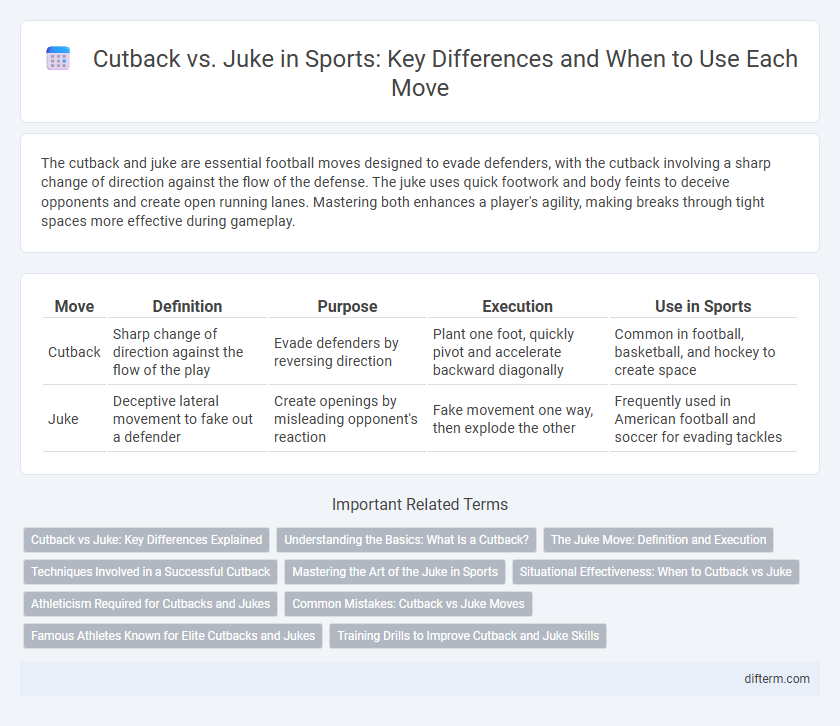The cutback and juke are essential football moves designed to evade defenders, with the cutback involving a sharp change of direction against the flow of the defense. The juke uses quick footwork and body feints to deceive opponents and create open running lanes. Mastering both enhances a player's agility, making breaks through tight spaces more effective during gameplay.
Table of Comparison
| Move | Definition | Purpose | Execution | Use in Sports |
|---|---|---|---|---|
| Cutback | Sharp change of direction against the flow of the play | Evade defenders by reversing direction | Plant one foot, quickly pivot and accelerate backward diagonally | Common in football, basketball, and hockey to create space |
| Juke | Deceptive lateral movement to fake out a defender | Create openings by misleading opponent's reaction | Fake movement one way, then explode the other | Frequently used in American football and soccer for evading tackles |
Cutback vs Juke: Key Differences Explained
Cutback and juke are fundamental football maneuvers used to evade defenders by changing the direction of a player's run, but they differ in execution and purpose. A cutback involves a sharp, quick plant and pivot to reverse or sharply alter the running lane, often used when an initial run is stopped by defenders, while a juke relies on rapid side-to-side footwork and body feints to deceive opponents without necessarily reversing course. Mastery of cutbacks emphasizes power and decisive movement to exploit gaps, whereas jukes prioritize agility and deception to create space in tight coverage situations.
Understanding the Basics: What Is a Cutback?
A cutback is a fundamental football maneuver where a player quickly reverses direction to evade defenders while advancing the ball. This move contrasts with a juke, which involves a feint or fake to mislead opponents, but a cutback requires sharp, sudden changes in momentum toward the original line of scrimmage. Mastering the cutback enhances a player's ability to exploit gaps in defensive formations and gain valuable yardage.
The Juke Move: Definition and Execution
The juke move in sports is a deceptive maneuver where a player quickly shifts their body weight and changes direction to evade a defender. Executing a juke requires sharp footwork, precise timing, and a sudden lateral movement to create separation. This technique is widely used in football and basketball to outmaneuver opponents and gain an advantage on the field or court.
Techniques Involved in a Successful Cutback
A successful cutback in sports requires precise body control and timing, with athletes using a sharp change of direction to evade defenders effectively. The technique involves planting the foot firmly while lowering the center of gravity to create balance and leverage for a swift turn. Proper use of peripheral vision to anticipate defender movements and rapid acceleration out of the cutback significantly enhances the effectiveness of this maneuver.
Mastering the Art of the Juke in Sports
Mastering the art of the juke in sports requires precise footwork and sharp directional changes to deceive defenders effectively. Unlike the cutback, which involves a sudden reverse of direction to exploit space behind defenders, the juke emphasizes quick lateral movement and body feints to create separation. Elite athletes in football and basketball employ juking techniques to enhance agility, improve evasion, and maintain offensive momentum against tight coverage.
Situational Effectiveness: When to Cutback vs Juke
Cutbacks are most effective when defenders overcommit or are pressured toward the outside, allowing the ball carrier to quickly change direction and exploit the vacated inside lane. Jukes work best in open-field situations where evading a single defender requires sudden lateral movements and deceptive footwork to create separation. Choosing between a cutback and a juke depends on the defensive alignment, field space, and the player's ability to read and react to defender positioning.
Athleticism Required for Cutbacks and Jukes
Cutbacks demand explosive lower-body strength and rapid directional changes, emphasizing a player's agility and balance to quickly evade defenders. Jukes require intense lateral quickness and precise footwork, relying on sudden shifts in body weight and sharp upper-body fakes to create separation. Both techniques challenge an athlete's neuromuscular coordination and fast-twitch muscle fibers, highlighting their overall athleticism in dynamic game situations.
Common Mistakes: Cutback vs Juke Moves
Common mistakes in executing cutback versus juke moves include improper foot placement leading to loss of balance and reduced agility. Players often telegraph their intentions by neglecting to disguise their moves, giving defenders a clear advantage. Failure to maintain a low center of gravity during both maneuvers decreases effectiveness in evading tackles on the field.
Famous Athletes Known for Elite Cutbacks and Jukes
Deion Sanders is renowned for his elite cutback ability, using sharp directional changes to evade defenders with precision and speed. Barry Sanders mastered the juke, showcasing incredible agility and quick footwork that left defenders off-balance and outmatched. Both athletes exemplify the highest level of skill in executing cutbacks and jukes, making them iconic figures in football history.
Training Drills to Improve Cutback and Juke Skills
Effective training drills for improving cutback and juke skills focus on agility, footwork, and reaction time. Ladder drills enhance quick, sharp movements critical for executing both cutbacks and jukes, while cone drills simulate defensive pressure, promoting precise directional changes. Incorporating plyometric exercises builds explosive power, enabling athletes to perform sudden stops and lateral moves with greater speed and control.
Cutback vs Juke Infographic

 difterm.com
difterm.com